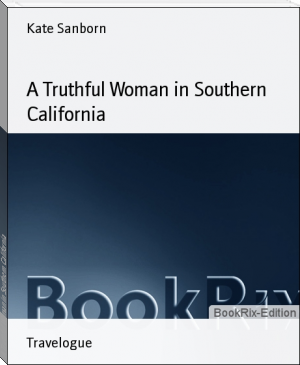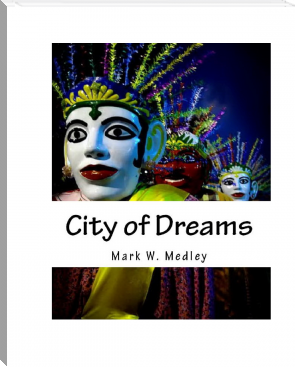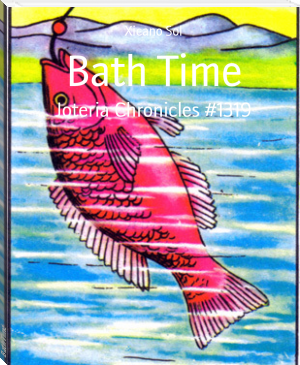A Truthful Woman in Southern California by Kate Sanborn (ebook pdf reader for pc .TXT) 📖

Download in Format:
- Author: Kate Sanborn
Book online «A Truthful Woman in Southern California by Kate Sanborn (ebook pdf reader for pc .TXT) 📖». Author Kate Sanborn
her attendants. Next comes the George Washington coach, modelled after the historic vehicle, occupied by stately dames and courtly gentlemen in colonial array; even the footmen are perfection in the regulation livery of that period. Solemn and imposing this may be, but they get a merciless shower of roses, and one of the prizes. And do look at the haymakers! Oh, that is charming! Country girls and boys on a load of new-mown hay, with broad-brimmed hats, and dresses trimmed with wild-flowers. And now the advance-guard is coming down again; they have just turned at the head of the line, and it is already a little confusing. But the judges! How can they keep cool, or even think, with such a clamor of voices, and guests chattering thoughtlessly to them. Here comes a big basket on wheels, handle and all covered with moss and roses. Four girls in pink silk trimmed with moss stand within, bearing shields of pink roses to protect their laughing faces from excess of attention. What a lovely picture! Another basket just behind covered entirely with marguerites; the wheels also are each a marguerite, the white horses with harness covered with yellow ribbon - so dainty, so cool. Is it better than the other? And here is a Roman chariot, a Spanish market-wagon, a phaeton covered with yellow mustard, a hermit in monastic garb; then Robin Hood and his merry men, and Maid Marian in yellow-green habit, Will Scarlet and Friar Tuck in green doublets, yellow facings, bright green felt hats, bows and quivers flower-trimmed, even the tiny arrows winged with blossoms. Now there are equipages three deep to survey instead of one, as they pass and repass in bewildering splendor. And do look! Here come the comicalities! "The Old Woman who lived in a Shoe" - a big floral slipper, with a dozen children in pink and gray-green, and the old woman on great poke-bonnet; a Japanese jinrikisha; an egg of white flowers, and a little boy hid away so as to peep and put out a downy head as a yellow chicken; a bicycle brigade; equestriennes; an interesting procession of native Californians, with the accoutrements of the Castilian, on horseback. One carriage is banked with marigolds, and the black horses are harnessed in yellow of the exact shade. It is fitly occupied by black-eyed Spanish beauties, with raven hair done up high with gold combs, and black lace costumes with marigolds for trimming, and takes a well-deserved prize.
Roses, roses, roses, roses! How they fly and fall as the fleeting display is passing! Thirty thousand on one carriage. Roses cover the street. And yet the gardens don't seem stripped. Where millions are blooming thousands are not missed. And not roses alone, but every flower of field and garden and conservatory is honored and displayed. Now the contestants are driving up to the grand stand to secure silken banners. Every one looks a little bit weary in procession and audience. Is it over? I murmur regretfully:
"All that's bright must fade,
The brightest still the fleetest;
All that's sweet was made
But to be lost when sweetest."
Yes, it is over! Waving banners, rainbow colors, showers of blossoms, rosy faces, mimic battle, fairy scenes, the ideal realized!
This is better than the New Orleans Mardi Gras, so often marred by rain and mud, with mythological ambiguities that few can understand, and difficult to interpret in passing tableaux; better than similar display at Nice and Mentone. This I do call "unique" and the only. Let Santa Barbara have this yearly festa for her own. She has fairly won the preëminence.
We at the comparatively frozen and prosaic north can indulge in gay coaching parades at Franconia, Newport, or Lenox, where costumes of gorgeous hues assist the natural beauty of the flowers. But it is only a coaching parade, at the wind-up of a gay season. We cannot catch the evanescent glamour, the optical enchantment, the fantastic fun, the exquisite art of making long preparation and hard work, careful schemes for effect, appear like airy nonsense for the amusement of an idle hour. We show the machinery. A true carnival can only be a success in a perpetual "summer-land," "within a lovely landscape on a bright and laughing seacoast." Taine said, "Give me the race, the surroundings, and the epoch, and I show you the man." Give me fair women, roses, sunshine, leisure, and high-bred, prancing steeds, and I show you this Santa Barbara Carnival.
But this is only a portion of the entertainment. There is a display of flowers at the Pavilion, where everything can be found that blooms in California, all most artistically arrayed; and more fascinating in the evening, when hundreds of tiny electric lights twinkle everywhere from out the grayish-green moss, and the hall is filled with admiring guests. There is always a play given one evening by amateur talent, a tournament, and a grand closing ball.
The tournament is exciting, where skilful riders try tilting at rings, trying to take as many rings as possible on lance while galloping by the wires on which these rings are lightly suspended - -a difficult accomplishment. Their costumes are elaborate and gay, but never outrè or bizarre, and no two alike. Each has his own color, and, like the knights of old, has a fayre ladye among the spectators who is especially interested and anxious for his success.
Next comes the Spanish game of "colgar," picking up ten-dollar gold pieces from the saddle, the horse at full speed. And the gymkhana race ends the games. Those who enter, saddle at the word "go," open an umbrella, and, taking out a cigar, light and smoke it - then see who first rides to the goal.
Last came the real vaqueros , and they ride untamed, unbroken horses, after a long and rather painful struggle to mount. They lasso mustangs and do wonderful things. But it was too much. I was glad to go and rest.
The Flower Dance at the ball, where human flowers formed intricate figures and dances for our edification and delight, was so attractive that my words are of no avail. Picture twenty-eight young ladies, each dressed to represent a flower - hollyhock, pansy, moss, rose, morning-glory, eucalyptus blossom, pink clover, yellow marguerite, Cherokee rose, pink carnation, forget-me-not, buttercup, pink-and-white fuchsia, lily of the valley, wine-colored peony, white iris, daffodil, and so on. They advance with slowly swaying motion, with wreaths uplifted until they reach the stage, where sit the guests of honor. There they bow low, then lay the garlands at their feet, and retire, forming ingeniously pretty groups and figures, while bees and butterflies flit in and out. See the bees pursuing the little pink rosebuds until at last they join hands and dance gaily away, only to be enthusiastically recalled.
Do you ladies want to understand a little in detail about the dresses? Of course you do. Well, here is the yellow marguerite:
Slender petals of yellow satin falling over a skirt of white silk crêpe, a green satin calyx girdle about her waist, and golden petals drooped again from the neck of her low bodice and over her shoulders.
A handsome brunette represented a wine-colored peony in a rich costume of wine-colored velvet and satin. The petals fell to make the skirt, and rose again from a bell sheathing the neck of her low corsage, and the cap on her dark hair was a copy of the flower.
There, you see how it is done. But it requires genius to succeed in such an undertaking. Look at Walter Crane's pictures of human flowers for more suggestions.
Most effective of all was the cachuca, danced by a girl of pure Castilian blood, who was dressed to symbolize the scarlet passionflower. The room was darkened save where she stood, and her steps and poses were full of Spanish fire and feeling, combined with poetic grace.
Yes, it is over, but the pictures remain as freshly colored as if I saw it all but yesterday.
During the Carnival sentiment reigns supreme - that is, if you have engaged rooms far in advance, and the matter of three daily meals is settled - and portly business men become gallant, chivalrous, and even poetic. In testimony I offer two verses sent to a lady visitor with a bunch of roses:
"We had not thought it was for aught
He lingered round us, scanning,
But to admire our spring attire,
The south wind softly fanning.
"But when we knew it was for you
Our charms he sought to capture,
All round the bower each budding flower
Blushed pink with rosy rapture.
"Lovingly,
THE ROSES."
George Eliot once said: "You love the roses - so do I! I wish the sky would rain down roses as they rain from off the shaken bush. Why will it not? Then all the valleys would be pink and white, and soft to tread on. They would fall as light as feathers, smelling sweet; and it would be like sleeping and yet waking all at once."
She never knew Santa Barbara.
I said the horses feel proud, and their owners tell me how they turn their heads to see their adornment. And well they may, for a true Barbareno loves his horse as does the Arab, and delights in his decoration. Easily first in this matter is Mr. W. D. Thompson, who came to Santa Barbara from Maine more than forty years ago, a nephew of the captain with whom Dana sailed. Mr. Thompson is a progressive man, who appreciates the many improvements achieved and contemplated, but still loves to tell of the good old times when he was roughing it as a pioneer. He has done a most important and valuable work in having a typical Mexican saddle and bridle of the most approved and correct pattern made out of the finest leather and several thousand silver dollars. As his favorite mare stood before me with this magnificent saddle on, and her forelegs tied with a little strap so that she could step daintily but not run, I never saw such a pretty sight of the kind. This saddle and bridle, worth over $3000, are now on exhibition in Chicago. No more significant or beautiful exhibition of the early argonautic period could be sent from Southern California, and it will surely attract constant and admiring attention. Here is a description from the San Francisco Argonaut :
"This saddle and bridle, manufactured of bullion from Mexican dollars, are exquisite works of art. The saddle is of typical Mexican pattern, with a high pommel, well-hollowed seat, and the most elaborate of trappings. The leather is stamped with elegant designs, and the whole thing is a complete, costly, and elaborate equipment, of good taste and artistic design. The saddle is studded over with silver ornaments. The leather facings are set thick with buttons and rosettes; the pommel is encased in silver; the corners of the aprons are tipped with silver; the stirrups are faced and edged with silver half an inch thick, elaborately chased and carved. The saddle-tree is hung with silver rings, fore and aft, to answer all the requirements of the vaquero in lacing up his riata. The girth, which passes under the horse's belly and cinches the
Roses, roses, roses, roses! How they fly and fall as the fleeting display is passing! Thirty thousand on one carriage. Roses cover the street. And yet the gardens don't seem stripped. Where millions are blooming thousands are not missed. And not roses alone, but every flower of field and garden and conservatory is honored and displayed. Now the contestants are driving up to the grand stand to secure silken banners. Every one looks a little bit weary in procession and audience. Is it over? I murmur regretfully:
"All that's bright must fade,
The brightest still the fleetest;
All that's sweet was made
But to be lost when sweetest."
Yes, it is over! Waving banners, rainbow colors, showers of blossoms, rosy faces, mimic battle, fairy scenes, the ideal realized!
This is better than the New Orleans Mardi Gras, so often marred by rain and mud, with mythological ambiguities that few can understand, and difficult to interpret in passing tableaux; better than similar display at Nice and Mentone. This I do call "unique" and the only. Let Santa Barbara have this yearly festa for her own. She has fairly won the preëminence.
We at the comparatively frozen and prosaic north can indulge in gay coaching parades at Franconia, Newport, or Lenox, where costumes of gorgeous hues assist the natural beauty of the flowers. But it is only a coaching parade, at the wind-up of a gay season. We cannot catch the evanescent glamour, the optical enchantment, the fantastic fun, the exquisite art of making long preparation and hard work, careful schemes for effect, appear like airy nonsense for the amusement of an idle hour. We show the machinery. A true carnival can only be a success in a perpetual "summer-land," "within a lovely landscape on a bright and laughing seacoast." Taine said, "Give me the race, the surroundings, and the epoch, and I show you the man." Give me fair women, roses, sunshine, leisure, and high-bred, prancing steeds, and I show you this Santa Barbara Carnival.
But this is only a portion of the entertainment. There is a display of flowers at the Pavilion, where everything can be found that blooms in California, all most artistically arrayed; and more fascinating in the evening, when hundreds of tiny electric lights twinkle everywhere from out the grayish-green moss, and the hall is filled with admiring guests. There is always a play given one evening by amateur talent, a tournament, and a grand closing ball.
The tournament is exciting, where skilful riders try tilting at rings, trying to take as many rings as possible on lance while galloping by the wires on which these rings are lightly suspended - -a difficult accomplishment. Their costumes are elaborate and gay, but never outrè or bizarre, and no two alike. Each has his own color, and, like the knights of old, has a fayre ladye among the spectators who is especially interested and anxious for his success.
Next comes the Spanish game of "colgar," picking up ten-dollar gold pieces from the saddle, the horse at full speed. And the gymkhana race ends the games. Those who enter, saddle at the word "go," open an umbrella, and, taking out a cigar, light and smoke it - then see who first rides to the goal.
Last came the real vaqueros , and they ride untamed, unbroken horses, after a long and rather painful struggle to mount. They lasso mustangs and do wonderful things. But it was too much. I was glad to go and rest.
The Flower Dance at the ball, where human flowers formed intricate figures and dances for our edification and delight, was so attractive that my words are of no avail. Picture twenty-eight young ladies, each dressed to represent a flower - hollyhock, pansy, moss, rose, morning-glory, eucalyptus blossom, pink clover, yellow marguerite, Cherokee rose, pink carnation, forget-me-not, buttercup, pink-and-white fuchsia, lily of the valley, wine-colored peony, white iris, daffodil, and so on. They advance with slowly swaying motion, with wreaths uplifted until they reach the stage, where sit the guests of honor. There they bow low, then lay the garlands at their feet, and retire, forming ingeniously pretty groups and figures, while bees and butterflies flit in and out. See the bees pursuing the little pink rosebuds until at last they join hands and dance gaily away, only to be enthusiastically recalled.
Do you ladies want to understand a little in detail about the dresses? Of course you do. Well, here is the yellow marguerite:
Slender petals of yellow satin falling over a skirt of white silk crêpe, a green satin calyx girdle about her waist, and golden petals drooped again from the neck of her low bodice and over her shoulders.
A handsome brunette represented a wine-colored peony in a rich costume of wine-colored velvet and satin. The petals fell to make the skirt, and rose again from a bell sheathing the neck of her low corsage, and the cap on her dark hair was a copy of the flower.
There, you see how it is done. But it requires genius to succeed in such an undertaking. Look at Walter Crane's pictures of human flowers for more suggestions.
Most effective of all was the cachuca, danced by a girl of pure Castilian blood, who was dressed to symbolize the scarlet passionflower. The room was darkened save where she stood, and her steps and poses were full of Spanish fire and feeling, combined with poetic grace.
Yes, it is over, but the pictures remain as freshly colored as if I saw it all but yesterday.
During the Carnival sentiment reigns supreme - that is, if you have engaged rooms far in advance, and the matter of three daily meals is settled - and portly business men become gallant, chivalrous, and even poetic. In testimony I offer two verses sent to a lady visitor with a bunch of roses:
"We had not thought it was for aught
He lingered round us, scanning,
But to admire our spring attire,
The south wind softly fanning.
"But when we knew it was for you
Our charms he sought to capture,
All round the bower each budding flower
Blushed pink with rosy rapture.
"Lovingly,
THE ROSES."
George Eliot once said: "You love the roses - so do I! I wish the sky would rain down roses as they rain from off the shaken bush. Why will it not? Then all the valleys would be pink and white, and soft to tread on. They would fall as light as feathers, smelling sweet; and it would be like sleeping and yet waking all at once."
She never knew Santa Barbara.
I said the horses feel proud, and their owners tell me how they turn their heads to see their adornment. And well they may, for a true Barbareno loves his horse as does the Arab, and delights in his decoration. Easily first in this matter is Mr. W. D. Thompson, who came to Santa Barbara from Maine more than forty years ago, a nephew of the captain with whom Dana sailed. Mr. Thompson is a progressive man, who appreciates the many improvements achieved and contemplated, but still loves to tell of the good old times when he was roughing it as a pioneer. He has done a most important and valuable work in having a typical Mexican saddle and bridle of the most approved and correct pattern made out of the finest leather and several thousand silver dollars. As his favorite mare stood before me with this magnificent saddle on, and her forelegs tied with a little strap so that she could step daintily but not run, I never saw such a pretty sight of the kind. This saddle and bridle, worth over $3000, are now on exhibition in Chicago. No more significant or beautiful exhibition of the early argonautic period could be sent from Southern California, and it will surely attract constant and admiring attention. Here is a description from the San Francisco Argonaut :
"This saddle and bridle, manufactured of bullion from Mexican dollars, are exquisite works of art. The saddle is of typical Mexican pattern, with a high pommel, well-hollowed seat, and the most elaborate of trappings. The leather is stamped with elegant designs, and the whole thing is a complete, costly, and elaborate equipment, of good taste and artistic design. The saddle is studded over with silver ornaments. The leather facings are set thick with buttons and rosettes; the pommel is encased in silver; the corners of the aprons are tipped with silver; the stirrups are faced and edged with silver half an inch thick, elaborately chased and carved. The saddle-tree is hung with silver rings, fore and aft, to answer all the requirements of the vaquero in lacing up his riata. The girth, which passes under the horse's belly and cinches the
Free ebook «A Truthful Woman in Southern California by Kate Sanborn (ebook pdf reader for pc .TXT) 📖» - read online now
Similar e-books:





Comments (0)